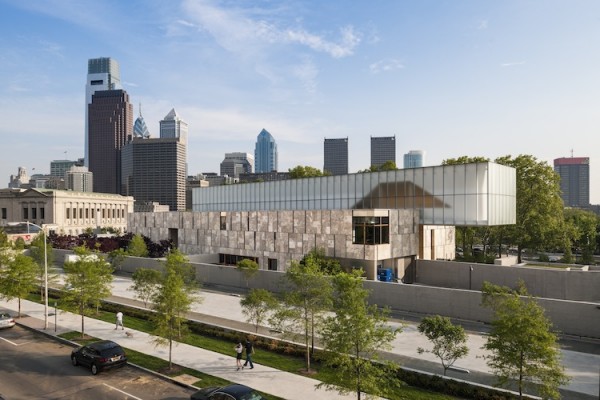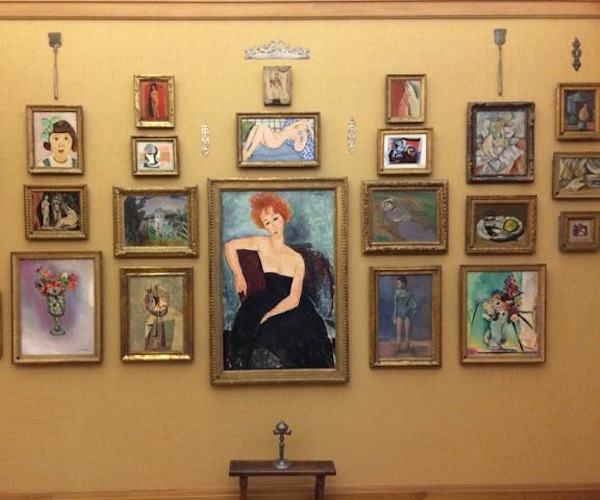Visual Arts Feature: Visiting The Barnes Foundation, Part Two
Walking through the Barnes is like nothing I had ever experienced before, overwhelming and brain-scrambling.

The Barnes Foundation during the day. Photo: The Barnes Foundation Archives and Special Collections, Merion, Pennsylvania.
[The first part of this piece on a visit to the Barnes Foundation can be found here.]
By Helen Epstein
The Barnes is located on the flag-bedecked Benjamin Franklin Parkway in central Philadelphia, half a mile from the Philadelphia Museum of Art. The building sits of 4.5 acre campus: a walled off, imposing, modern-minimalist construction. An effort was made to evoke the original Merion site, with evergreens, lawns, and plantings to evoke the garden setting. Jerusalem stone blocks from the Negev serve as substitute for the original French limestone exterior.
From the outside, the Barnes resembles the renovated Boston MFA, The Clark Institute, and Harvard Art Museums. But since we had no nostalgic memories of Merion, we weren’t put off by the contemporary architectural conventions that so infuriate some of the locals. On a Thursday afternoon in mid-December there was no one on the tidy walkways and no water in the reflecting pool. The Annenberg Court — designed to separate the “entrance experience” from “the gallery experience” as well as accommodate live performance and corporate parties — was occupied only by the museum guards and two groups of school children with their teachers, all dwarfed by the vast space.

Kids visiting the Barnes. Photo: courtesy of Helen Epstein.
We crossed the timeline from 2012 to 1922 through a stone passage demarcated by an ornate grand gate. But nothing could prepare us for the shock of sudden immersion in the oblong, graceful, high-ceilinged but intimate Main Room.
Sensory overload. A smorgasbord of colors, shapes, subjects, styles. Paintings of every size. Huge. Small. Some instantly recognizable as the work of Renoir or Cezanne; some unfamiliar. All elaborately framed. Unusual presentation. Not set off by empty space or arranged in thematic or chronological fashion, but crowded together on the mustard-colored walls with little space between their frames. All claiming my attention. Impossible to choose one.
Absent are the blocks of explanatory wall text characteristic of most museums. Cognitive dissonance. Instead of those reassuring white squares or rectangular points of reference, the paintings are punctuated by metal objects I’d never before seen on the walls of an art museum: a pastry cutter; a door knocker; calipers; weathervanes; keys; implements whose function I couldn’t identify. And above it all, Matisse’s mural “The Dance.”
I sank down on the bench and let my eyes pan over the walls. The West Wall features Seurat’s monumental (6 by 8 foot) “Models” sitting over Cezanne’s almost as large “The Card Players,” flanked by smaller canvases by Maurice Prendergast and Henri Rousseau. Beneath the long Matisse mural, framed by three floor to ceiling windows, the South Wall was hung with just two imposing, unfamiliar paintings: “Seated Riffian,” also by Matisse and “The Peasants” by Picasso. The East Wall juxtaposed more Renoir and Cezanne with Tintoretto, Daumier, and Glackens. The long North Wall held over 30 smaller Renoirs and Cezannes, all surrounded by ribbons of metalwork. The word “oxymoron” floated to mind: the yoking together of disparate objects, the conceit used by Metaphysical poets to startle the reader into new perceptions.
We had reserved a tour with a Barnes-trained docent. Penny Hansen was accustomed to the dazed and confused reactions of first-time visitors to the Barnes and tactfully kept silent as we sat trying to take in the spectacle before us. It was like nothing I had ever experienced before, overwhelming and brain-scrambling. After a few silent minutes, we decided to walk through the entire two floors of rooms with our docent and then return by ourselves.

Matisse’s mural “The Dance.” Photo: Courtesy of The Barnes Foundation Archives and Special Collections, Merion, Pennsylvania.
Penny, like many of Barnes’s workers and eventual students, had little background in art or art history. She had arrived in Pennsylvania from Oxford, England and lived near the Merion campus. Like all Barnes docents, she had completed two years of art education classes at the institution, very much like the Adult Art Education courses that Barnes had established in the 1920s.
Penny explained the striking exhibition strategy that Barnes insisted upon. He conceptualized each wall of each gallery as a mixed tableau of paintings, sculpture, industrial and decorative art, and furniture that he called an “Ensemble.”
The objects and paintings in his ensembles echo one another in subject or color or constellations of figures or shapes. Sometimes there’s humor in the placement: two paintings of particularly fleshy, broad-bottomed women hang above two extra-wide seats of Winsor chairs. Or a flat-planed Modigliani portrait is juxtaposed with an elongated, flat kitchen spatula.
Every ensemble displays Barnes’ OCD-like concern with balance and symmetry, to the point of his selecting the position of pictures by mere size or shape above other criteria. A small room of small works on paper is the only one that feels undigested and overcrowded. Though Barnes kept reconfiguring these ensembles almost until the day he died, the Foundation mandates that each ensemble be frozen in the configuration it was at the time of his death in 1951. That part of Dr. Barnes’s legacy has been scrupulously respected.
Barnes was no mere millionaire collector, I found myself thinking, but an ultra-controlling theatrical director or installation artist, rich enough to use the whole Merion building as his installation. Walking through the collection, I experienced each wall as a stage set of a theater. But the emotional valence of most of the components — the paintings — was so great that most of the time I ended up disregarding the mise en scene.

Sensory overload at The Barnes. A smorgasbord of colors, shapes, subjects, styles. Photo: Courtesy of Helen Epstein.
Penny pointed out familiar signposts. There are in fact plaques on the frames that identify the painters, though they are small, faint, and difficult to read. There are also diagrams of each wall (tucked onto the back of the benches) for viewers who desire to know the name, date, and creator of the paintings they are viewing, as well as the provenance of the furniture and metalwork. That metalwork, which functions like mosaic pieces throughout the galleries and provides a unifying thread, has been dipped in acid and specially lacquered. That explained its uniform gray color and matte finish.
The 23 galleries at the Barnes, she told us, were reconstructed to the exact solar orientation and supposedly to within one/tenth of a millimeter of the dimensions of the original rooms in Merion. The lighting, however, had been vastly improved and was regulated by computer. When she was a student, “you used to need a flashlight to see some of the work.” Now special window shades automatically lower and rise depending on the light outside. The new lighting has transformed the way the paintings look so much that some experts think they have been cleaned.
The rooms were surprisingly uncrowded on the winter Thursday afternoon and Friday morning we spent there. I sat alone for minutes at a time surrounded by masterworks. In Merion, only 250 visitors per week were allowed in. Now, 250 visitors at a time are admitted. Every visitor is clocked in and out, so entry becomes the luck of the draw. In high tourist season, even with reserved all-day tickets at $35, you may still have to wait in line for admission.

Sometimes there is humor in the placement: broad-bottomed woman hung above extra-wide seat of Windsor chair. Photo: Courtesy of Helen Epstein.
Though sketching is still not allowed at the Barnes, reproductions of many paintings are available from the gift shop on postcard, poster, and canvas. There is a seminar room in which you can view an instructional film and browse art books, as well as a library for more serious research.
What’s the optimal way to visit the Barnes? If I had to do it again, I’d reread The Devil and Dr. Barnes thoroughly just before flying to Philadelphia. I’d also take advantage of the virtual tour on the Barnes App to get a sense of which ensembles and pictures I wanted to be sure to spend time with in the galleries.
Barnes did not manage to buy up the best Renoirs, but he acquired hundreds of extraordinary paintings, large and small, and many beautiful industrial and decorative objects. One is repeatedly shocked by an unfamiliar painting by an otherwise familiar artist whose work you’ve long viewed and studied. I was delighted to see such a picture by Lautrec of one of his (and my) favorite models, Carmen Gaudin. Other intriguing works I had never seen before: a Degas group of nudes (featuring a pair of bare, knock-kneed legs), Daumiers, Rousseaus, Gauguins, and even an unusual nude by Van Gogh.
I won’t be able to refer to Picasso’s Blue Period again without remembering the arresting hues of “The Ascetic.” Or to think of Manet’s or Monet’s paintings without putting them in the context of Cezanne and Matisse. Dr. Barnes’s prescribed scrambling of styles stayed with us long after we left the Barnes. Before leaving, we loaded up on the posters and reproductions that are unavailable anywhere else and bought a copy of Masterworks, the beautifully produced catalogue from the Barnes.
If you’re a New Englander looking for a unique winter art getaway, you could do no better than to get thee to Philadelphia.
Helen Epstein is a cultural journalist and author whose work, including a profile of art historian Meyer Schapiro, can be found at Plunkett Lake Press.

Today the Barnes announced that Thomas Collins, head of the resurgent Pérez Art Museum in Miami, is its new director.
http://www.philly.com/philly/news/20150107_Barnes_foundation_announces_a_new_director.html